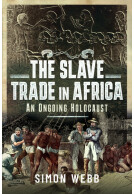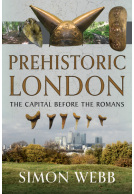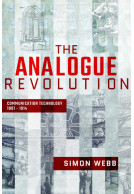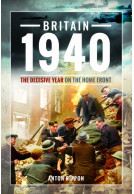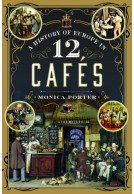The Real World of Victorian Steampunk (Paperback)
Steam Planes and Radiophones
Imprint: Pen & Sword History
Pages: 155
Illustrations: 32
ISBN: 9781526732859
Published: 3rd June 2019
(click here for international delivery rates)
Order within the next 1 hour, 40 minutes to get your order processed the next working day!
Need a currency converter? Check XE.com for live rates
| Other formats available | Price |
|---|---|
| The Real World of Victorian Steampunk ePub (5.1 MB) Add to Basket | £6.99 |
In the last few decades, steampunk has blossomed from being a rather obscure and little-known subgenre of science fiction into a striking and distinctive style of fashion, art, design and even music. It is in the written word however that steampunk has its roots and in this book Simon Webb explores and examines the real inventions which underpin the fantasy. In doing so, he reveals a world unknown to most people today.
The Real World of Victorian Steampunk shows the Victorian era to have been a surprising place; one of steam-powered aeroplanes, fax machines linking Moscow and St Petersburg, steam cars travelling at over 100 mph, electric taxis and wireless telephones. It is, in short, the nineteenth century as you have never before seen it; a steampunk extravaganza of anachronistic technology and unfamiliar gadgets. Imagine Europe spanned by a mechanical internet; a telecommunication system of clattering semaphore towers capable of transmitting information across the continent in a matter of minutes. Consider too, the fact that a steam plane the size of a modern airliner took off in England in 1894.
Drawing entirely on contemporary sources, we see how little-known developments in technology have been used as the basis for so many steampunk narratives. From seminal novels such as The Difference Engine, through to the steampunk fantasy of Terry Pratchett’s later works, this book shows that steampunk is at least as much solid fact as it is whimsical fiction.
It was very interesting reading and the bits of history and technology explored were fascinating and tallied with things I already knew. The information provides greater depth to the reading of steampunk novels because a good writer in the genre needs to know actual history to be able to pull off a convincing story and the references to real events, people and inventions add to that.
Rosie Writes...
Read the full review here
Listed in the 'For Your Bookshelf' feature
Antiques Diary, November 2019
In sum, this is a great book, a joy to read, informative, and inspiring. It will delight equally lovers of history, steampunk novels, and researchers interested in the topic. Readers and writers will find much to ponder upon (I’ve finished the book with a long list of other books to read), and it occurred to me as I read it, that writers of post-apocalyptic fiction would find it a good source of inspiration, as it has all kind of suggestions for contraptions and inventions that could have taken over the world if things had been different. Highly recommended.
Author Translator, Olga Nunez Miret
Read the full review here
I was very impressed by this book. It mixes the real Victorian London era with the steampunk equivalent as comparison. If I have to pick fault, then I wish Simon Webb had criticised these steampunk authors for where they had gone seriously wrong but that’s a minor quibble. Certainly, if you want to write steampunk, then this book should be required reading. If you just want to understand the scientific and technological underbelly of the Victorian era then it’s a must read.
SF Crowsnest
Read the full review here
The book is very well produced, with a carefully chosen typeface and clear page layout... this is a very interesting book which is well worth a read.
Magonia Review
Read the full review here
Rating: 5 out of 5 stars
NetGalley, Deborah White
This is a book about how the fiction genre of Victorian Steampunk is inspired by attempted inventions or real technology created during the reign of Victoria. The author started by explaining what steampunk is, and he frequently referred to various novels that were inspired by the real technology that he's describing. I think this book was aimed more at fans of this genre than history buffs as I've read most of this material in more detail in books by other authors. This was more of an overview of the many ideas that were coming out at the time with some general descriptions of how they worked and why they didn't endure.
He talked about various steam-powered vehicles (cars, buses, lorries, dirigibles, a motorcycle, and a plane) and described why petrol vehicles "won" when electric and steam-powered vehicles were much more desirable (quieter, more reliable, etc.). He described several stretches of pneumatic railway that were actually built and why the technology was abandoned. He talked about wind-powered cars, the mechanical telegraph network, mechanical computers and calculators, wireless sunlight phones, telegraph fax machines, recording voice on metal wire or disks, their understanding of how televisions could be made, home stereo music over the telephone line, attempts to make mechanical men or animals, and solar-powered generators.
Rating: 5 out of 5 stars
NetGalley, Vivienne O'Regan
A highly informative study that explores the real inventions mainly during the Victorian period that inspired the sub genre of steampunk in science fiction and fantasy, which has further influenced fashion, art, and design.
Webb clearly has a strong grasp of the technology of the period covered alongside a passion for the literature associated with steampunk. He cites many works and their relation to the original inventions.
It really is a treasure trove and almost on every page I found that I was amazed by the revelations including of many inventors and their inventions sidelined by history. I had no idea that the electric car predated the petrol driven one by decades or that Victorians were exploring solar power and other sustainable energies.
I felt that I was learning a great deal about the history of science and technology alongside a deeper appreciation of steampunk in literature.
In his Endword Webb writes: “The world created by the authors of steampunk novels and short stories strikes us as outlandish and fantastic, simply because we do not know enough about the history of the real world in which we live. It is hard to find a single invention mentioned in steampunk literature which did not have its counterpart in the age of the Victorians.”
He concludes: “Steampunk, although generally described as a genre of science fiction, has in fact far more in common with science fact than most aficionados ever realize.”
Just fascinating from start to finish. I would love to see this commissioned as a television series! Highly recommended.
Rating: 5 out of 5 stars
NetGalley, Colin Edwards
Read. This. Book. I confess that the title didn’t really appeal to me. I have a vague concept of what steampunk is, but I would I describe my interest as being on the tepid side of mild. However, this is the most interesting non-fiction book – no, scrap that qualifier. This is THE most interesting book I have read for a looooong time.
This book is very well researched indeed. The author, Simon Webb, is obviously a steampunk fan and this book simply seeks to explain the real science and inventions behind some of the fictional technology in steampunk books. I couldn’t believe how long ago the first versions of what we consider to be modern technology appeared. Yet, what could have been a dry-as-dust geeky tome is very well written and is very readable indeed.
Rating: 5 out of 5 stars
NetGalley, Tamara Hayessen
This was a great book to read! I love history and I know a lot about it, I would say, but here were so many new things for me that I couldn't stop being surprised. I've learnt so much by reading this book. The style is very easy, even for somebody like me (not being a mother-tongue Englisch speaker), I could understand even the technical details, which I didn't expect. The author knows how to make the reader interested, mostly through this connection to steampunk novels. I love it that the author does nor only describe the different machines or vehicles, but also answers the questions why we use the vehicles or machines we do. It is this bigger picture that makes the book even more fascinating.
A great read!
This is an interesting book, full of interesting facts and information.
NetGalley, Anna Maria Giacomasso
It's well researched, informative and entertaining.
About Simon Webb
Simon Webb is the author of a number of non-fiction books, ranging from academic works on education to popular history. He works as a consultant on the subject of capital punishment to television companies and filmmakers and also writes for various magazines and newspapers; including the Times Educational Supplement, The Daily Telegraph and The Guardian.









